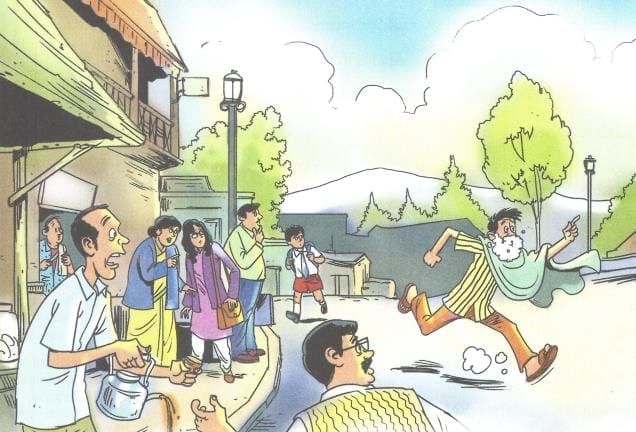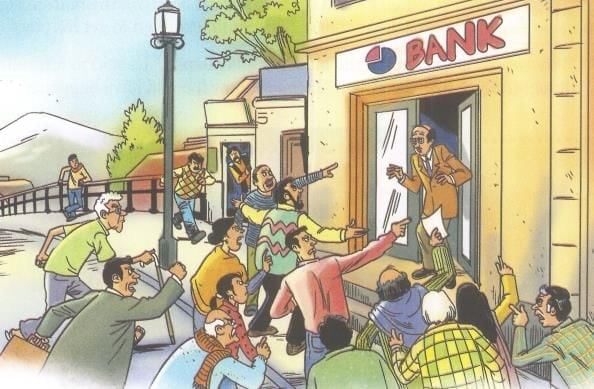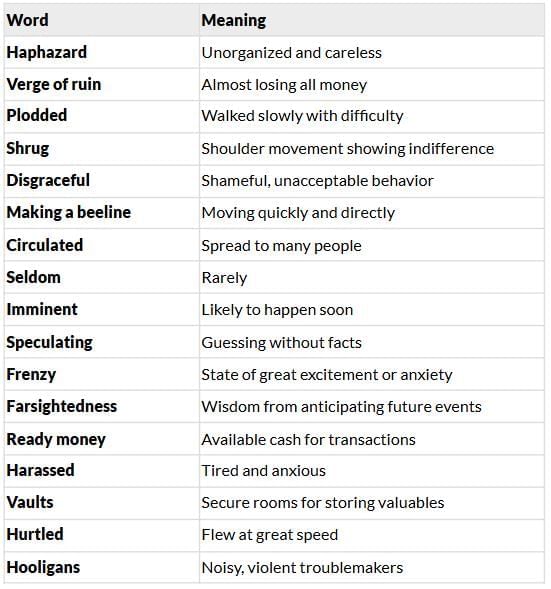The Boy Who Broke the Bank Chapter Notes | Gul Mohar Class 8: Book Solutions, Summaries & Worksheets PDF Download
| Table of contents |

|
| About the Author |

|
| Key Points |

|
| Detailed Summary |

|
| Theme |

|
| Message |

|
| Vocabulary |

|
About the Author
Ruskin Bond, a beloved Indian writer, is known for his stories about people and places in the Himalayan foothills. His works capture the simplicity and charm of small-town life with humor and empathy. The Boy Who Broke the Bank illustrates how rumors can spiral out of control, reflecting human behavior in a crisis.
Key Points
- Nathu, a sweeper-boy at Seth Govind Ram’s bank, grumbles about delayed wages, sparking a conversation with Sitaram, a washerman’s son.
- Sitaram mentions Nathu’s unpaid wages to Mrs. Prakash, who assumes the bank is bankrupt and spreads the news to Mrs. Bhushan.
- The rumor escalates through the bazaar, causing panic as people believe the bank is collapsing and rush to withdraw money.
- A customer, nicked during a haircut, spreads the news further, suspecting Seth Govind Ram has fled, fueling chaos.
- The bank runs out of ready money, and an angry crowd, including mischief-makers, protests, throwing stones and breaking a window.
- Police disperse the crowd, and Nathu, unaware of his role, laments the mess and waits for his pay, puzzled by the bank’s supposed collapse.
Detailed Summary
In The Boy Who Broke the Bank by Ruskin Bond, a simple complaint spirals into chaos in a small Himalayan town. Nathu, a sweeper-boy at Seth Govind Ram’s bank, grumbles while cleaning the bank’s steps, frustrated that his wages are two months overdue. He vents to Sitaram, a washerman’s son passing by with laundry, declaring he’ll quit once paid. Sitaram, trying to help, mentions Nathu’s plight to Mrs. Prakash while delivering clothes, suggesting the bank’s financial trouble as the reason for delayed payments.
 Mrs. Prakash, gossiping under a tamarind tree, tells Mrs. Bhushan the bank can’t pay its employees, implying it’s in a “disgraceful” state. Mrs. Bhushan, exaggerating the story, informs her husband and Jugal Kishore, who alerts Faiz Hussain, a barber. Faiz, startled, nicks a customer’s ear, who, in pain and distress, rushes to a phone, learning Seth Govind Ram is supposedly holidaying in Kashmir. Suspecting he’s fled, the customer spreads the rumor of the bank’s imminent collapse.
Mrs. Prakash, gossiping under a tamarind tree, tells Mrs. Bhushan the bank can’t pay its employees, implying it’s in a “disgraceful” state. Mrs. Bhushan, exaggerating the story, informs her husband and Jugal Kishore, who alerts Faiz Hussain, a barber. Faiz, startled, nicks a customer’s ear, who, in pain and distress, rushes to a phone, learning Seth Govind Ram is supposedly holidaying in Kashmir. Suspecting he’s fled, the customer spreads the rumor of the bank’s imminent collapse.
[Intext Question]
The news spreads like “forest fire” through the bazaar, reaching tea shops, vendors, and even a beggar. The town, rarely facing crises, erupts into a frenzy, with people speculating about Seth’s whereabouts and boasting of their farsightedness in avoiding the bank. A clerk clarifies the delay is due to a sick colleague, not insolvency, but the panicked crowd demands ready money. The harassed bank manager, out of cash, promises withdrawals the next day, but mischief-makers join the mob, throwing stones and smashing a window. 
Police disperse the crowd, who vow to return. The next morning, Nathu, seeing the refuse and broken glass, curses “goondas” and “hooligans,” unaware his complaint sparked the chaos. Sitaram, arriving, casually mentions the bank’s collapse, urging Nathu to demand his pay. Nathu, muttering in disbelief, sits on the steps, determined to get his wages, pondering how the bank could have collapsed.
[Intext Question]
Theme
The story explores the power of rumors, human gullibility, and the chaos of misinformation. It highlights how a small misunderstanding can escalate into widespread panic in a close-knit community.
Message
The message is that rumors, fueled by fear and exaggeration, can cause unnecessary chaos and harm. Bond uses humor to show that clear communication and critical thinking are essential to prevent minor issues from spiraling out of control.
Vocabulary

|
32 videos|62 docs|17 tests
|
FAQs on The Boy Who Broke the Bank Chapter Notes - Gul Mohar Class 8: Book Solutions, Summaries & Worksheets
| 1. What is the main theme of "The Boy Who Broke the Bank"? |  |
| 2. Who are the key characters in the story, and what roles do they play? |  |
| 3. What message does the author convey through the story? |  |
| 4. How does the setting influence the events in "The Boy Who Broke the Bank"? |  |
| 5. What vocabulary is important to understand the story better? |  |















